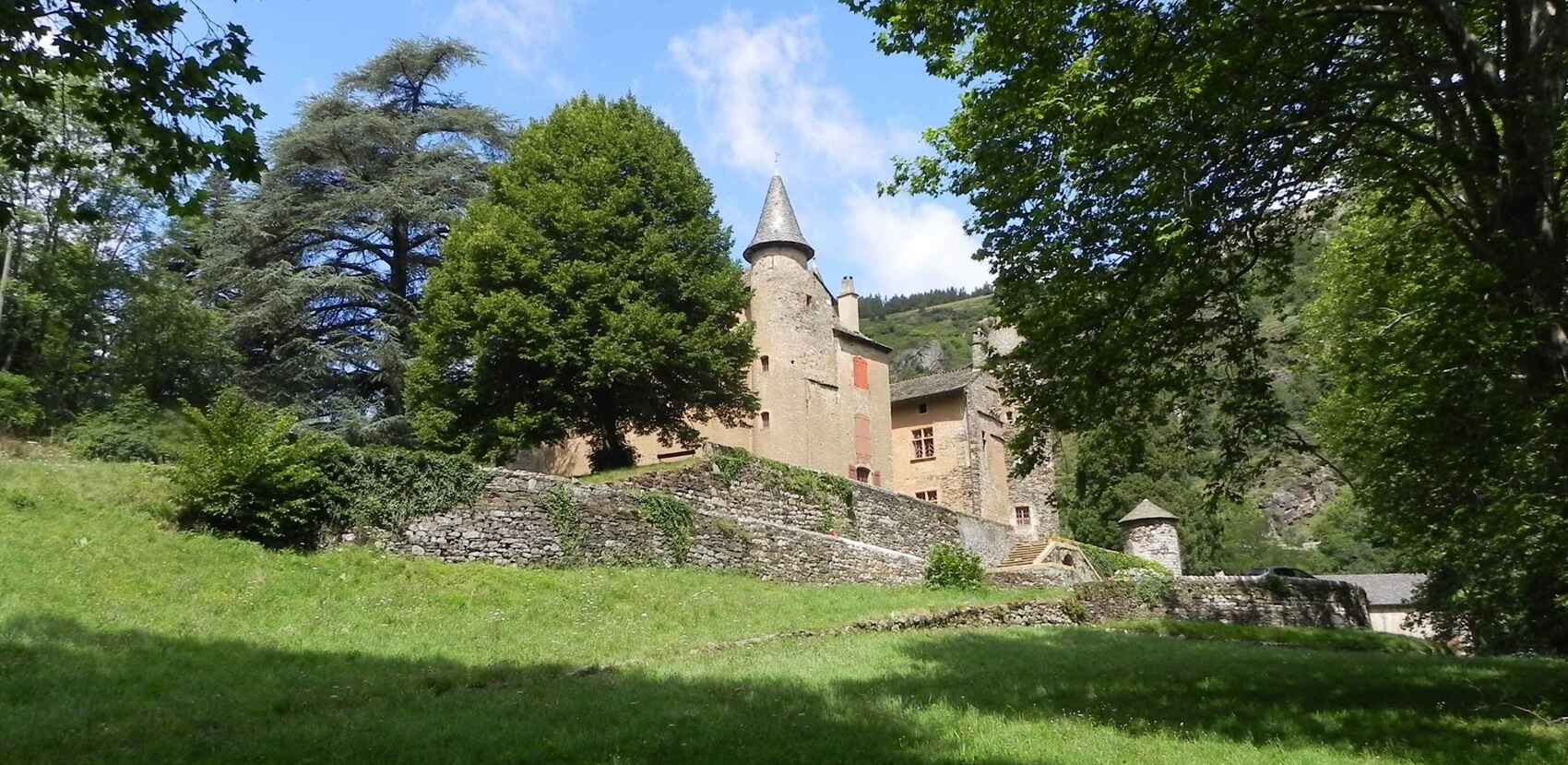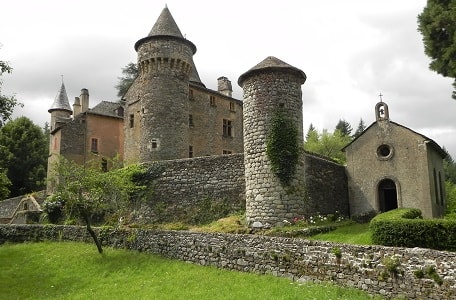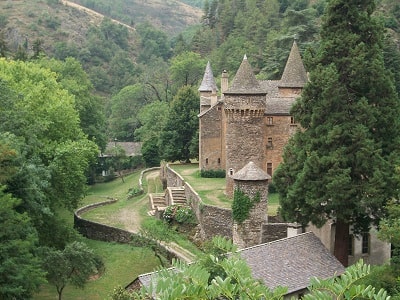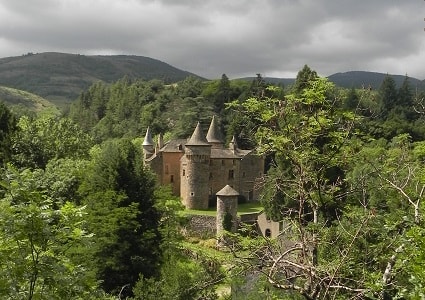Champ Castle in Altier |
Champ Castle has stood elegantly on the banks of the Altier River in the heart of the Lozère region since the 13th century. This former medieval fortress was extensively remodeled in the 15th century to become a more comfortable and refined stately residence. A historic property of the de Borne family, the building is distinguished by its massive square keep and watchtowers overlooking the terraced gardens. Its architecture offers a perfect synthesis of military defensive elements and the wider openings characteristic of the pre-Renaissance period. A listed historical monument, the site is surrounded by a wooded park that underscores the wild and unspoiled character of the surrounding valley. Through the Wars of Religion and the centuries, the château has remained a symbol of the power of the local nobility in the Gévaudan region. Today, visitors can admire the exceptional preservation of its gray granite facades, which change hue depending on the light. This private estate remains one of the best-preserved jewels of Lozère's heritage, bearing witness to eight hundred years of continuous human presence.

 Located on a small rocky promontory surrounded by the Altier River, near departmental road 901, just before Altier when coming from Mende, the Château du Champ is admired by all passing tourists. It consists of a single rather massive three-story building. It is remarkable for its pepper pots that top the towers. One of them is crowned with a walkway.
Located on a small rocky promontory surrounded by the Altier River, near departmental road 901, just before Altier when coming from Mende, the Château du Champ is admired by all passing tourists. It consists of a single rather massive three-story building. It is remarkable for its pepper pots that top the towers. One of them is crowned with a walkway.
The site of the Château du Champ has been classified since 1942. The facades, roofs, and park of the Château have been listed in the supplementary inventory of historical monuments since April 14, 1965. The castle is located in the Cevennes National Park.
The origin of the castle dates back to the end of the 13th century. It is said, however, that it was built on the site of a very ancient settlement.
Documents report that the land of Altier was undivided between the powerful lords of Randon and several younger members of the Altier family, who shared the “castrum” of the village located on the heights of the great Altier, of which ruins can still be seen today. This led to many points of contention between the officers of Randon, whose lordship was dominant, and the other co-lords, so much so that one of them decided to withdraw and went to build his stronghold on lands he owned along the river, at the current location of the Château du Champ.
A first mention of Champ dates back to 1277, on the occasion of a homage served by the brothers Pierre and Gaucelin d’Altier to the lord of Randon, in which he declares among other things the farm “del campo”.
It is the son of Gaucelin, Raymond d’Altier, who undertakes the construction of the new castle, which can be dated between 1288 and 1308. It is at this date that his wife wrote her last wishes “al cham”.
 Later, on August 20, 1322, Raymond d’Altier received a donation from Guillaume de Randon, lord of Luc, for the high justice of the newly fortified Champ, and he swore homage to him.
Later, on August 20, 1322, Raymond d’Altier received a donation from Guillaume de Randon, lord of Luc, for the high justice of the newly fortified Champ, and he swore homage to him.
The d’Altier family would keep the Champ for three generations, with the family falling into disarray with Delphine d’Altier, heiress of the lands of Champ, Felgère, and Serres, two other lordships located in Uzège. Delphine first allied with her cousin Louis d’Altier, the only descendant of another branch of the family, which had remained at the castle of Grand Altier. Louis d’Altier died shortly after without children, so Delphine found herself the heir of a new heritage, uniting all the properties of the two lines of Altier, separated since the 13th century.
Delphine d’Altier married Armand de Borne, a knight belonging to the diocese of Le Puy, in a second marriage. This resulted in the creation of a new house of Altier, firmly established in Champ for about a dozen generations (until 1812).
The successors of Delphine d’Altier initially only bore the name Altier, but by the end of the 14th century, the name Borne was added to the surname Altier.
In the 18th century, the form Borne d’Altier prevailed, and the surname Budos was also added: brilliant alliances were made with the provincial nobility, notably the marriage of Jean de Borne d’Altier in 1497 with the eldest daughter of Thibault de Budos, baron of Portes, which connected them with the Montmorency and later with the princes of Conti. This alliance opened up the prospect of a reputedly fabulous inheritance for the Cevenols, for whom the mirage of the château of Portes has always been of great allure.
 Subsequent unions were made with more local houses. We find the Yzarn de Castanet, whose castle is located a few kilometers from Champ, the Molette de Morangiès, the d’Albignac, the Bardon du Choizal in Mende, which brought their castle to the d’Altier on the Causse de Sauveterre, and especially the Malbosc du Miral.
Subsequent unions were made with more local houses. We find the Yzarn de Castanet, whose castle is located a few kilometers from Champ, the Molette de Morangiès, the d’Albignac, the Bardon du Choizal in Mende, which brought their castle to the d’Altier on the Causse de Sauveterre, and especially the Malbosc du Miral.
Jean Antoine Hercule de Borne d’Altier, in his forties and without children from two previous marriages, decided on a third union in 1743 with a neighbor, Mlle du Miral, barely aged 20, who became heir to part of the estate after the death of her younger brother.
(The château of Miral is located south of Mont-Lozère on the road connecting Florac to Pont-de-Montvert).
Charles Jean-Baptiste Victor de Borne, count of Altier, marquis of Champ, was executed on July 9, 1794. His eldest son emigrated.
During the Revolution, the towers were razed, the lands and the château were seized and sold in 1796 as national property. In 1812, the last descendant of the Borne d’Altier died without descendants after having repurchased the château from his aunt, who had herself bought it from the administration so that it would always remain in the family. The succession went to the little cousin, Jules de Chapelain, sub-prefect of Marvejols. In the third generation of the Chapelain family, Joseph had only daughters, and the Champ was transferred to the Raguenet de Saint Albin family (1905), Gourcy (1919), and then Varin d’Ainvelle (1928).
In 1981, in light of the scale, urgency, and cost of the work to be carried out, Madeleine Varin d’Ainvelle decided to create, with 17 of her nephews and nieces, a real estate company with the aim of restoring and preserving this family and Lozère heritage. Since 1985, all the roofs of the château and its towers have been rebuilt with slates from Tournel. The refurbishment of the roof of the château's outbuildings during the winter of 2005/2006 marked the last stage of these renovation works. Each year, the château can be visited during the European Heritage Days.
Former holiday hotel with a garden along the Allier, L'Etoile Guest House is located in La Bastide-Puylaurent between Lozere, Ardeche, and the Cevennes in the mountains of Southern France. At the crossroads of GR®7, GR®70 Stevenson Path, GR®72, GR®700 Regordane Way, GR®470 Allier River springs and gorges, GRP® Cevenol, Ardechoise Mountains, Margeride. Numerous loop trails for hiking and one-day biking excursions. Ideal for a relaxing and hiking getaway.
Copyright©etoile.fr